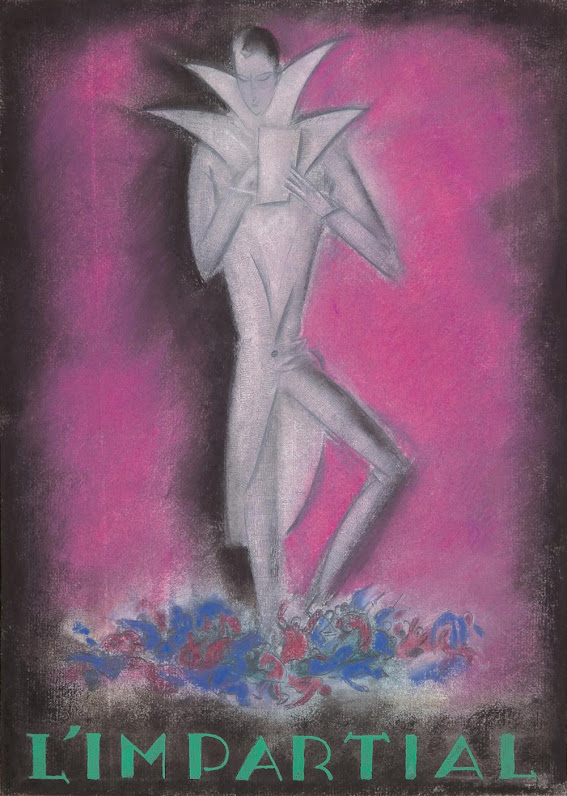Charles Loupot (1892 – 1962) was a French poster artist and painter. He was one of France’s most significant poster artists, along with A. M. Cassandre, Paul Colin, and Jean Carlu. His pioneering use of the lithographic technique was widely celebrated across his fifty year career. Born in Nice, France, to David Loupot and Joséphine Grassi. In 1907 the family relocated to Lausanne, Switzerland, where Loupot completed his education. In 1911 Loupot was enrolled in the École des Beaux-arts de Lyon, where he took classes in painting and life drawing, and experimented with lithography. The outbreak of the first world war put an abrupt end to these studies, as Loupot was conscripted to fight and amongst the first to be sent to the front. He was quickly injured, however, and sent back to his parents in Lausanne for a period of convalescence.
Loupot moved to Paris in 1923 and began working for Maison Devambez. His innovative posters for the automobile company Voisin quickly established Loupot as a pioneering figure on the design scene. In the same year, A.M. Cassandre - with whom Loupot would later collaborate - produced 'Le Bûcheron', also representing a radical departure from the established Art Nouveau style. Loupot and Cassandre, along with Paul Colin and Jean Carlu, were nicknamed the 'Musketeers' by critics, and seen to be ushering in a new era of poster design
His studio became a popular meeting place for a range of creatives based in Lausanne, including the photographer Émile Gos, and the writer Charles Ramuz. At this time Loupot also met Marcelle Vittet, his future wife, who would model for a number of his designs
Following WW2 Loupot produced series of meticulous designs, that increasingly pushed the boundaries between abstract and figurative works. This change in his style is exemplified in his work for St-Raphaël. This shift has been ranked amongst the most iconic examples of the advertising revolution of the twentieth century. By 1950 the majority of laws against alcohol advertising had been lifted, although some restrictions remained. That year, with the help of Max Augier (by then good friends with Loupot), Loupot formed his own advertising agency, called 'Les Arcs’. Whilst St-Raphaël remained Loupot's major client, he was free to take on other commissions, and worked with Nicolas again. As with his work for St-Raphaël, Loupot's post-war Nicolas designs were radically simplified from their original inter-war appearance.
Although Loupot was most famous for his work as a commercial poster, privately he also experimented extensively with painting. These works were not intended to be sold, and were principally images of his surroundings, friends, and lovers. There is, however, some suggestion that Loupot was occasionally commissioned as a decorator at the beginning of his career in Paris, although details surrounding this are unclear. His most significant contribution to painting was the chapel, Notre-Dame-de-la-Tête-Ronde à Menou, that he decorated in the 1950s.
This is part 1 of a 4-part series on the works of Charles Loupot:
 |
1908 Saison-Neuheiten Gebr. Loeb Söhne, Bern 137 x 89 cm |
1912 Rentrée des classes
Innovation, Lausann
130 x 90 cme
 |
| 1913 Bal des Etudiants (Students' Ball) 161.5 x 116 cm |
 |
| 1914 Meubles progrès (Progress Furniture) Tapis d'Orien (Oriental Carpets) 131 x 92 cm |
 |
| c1916 Spielwaren (Toys) Gebrüder Loeb Söhne (Brothers Loeb & Sons) 178 x 109 cm |
 |
| 1916 Puppen (Dolls) Léon Nordmann & Cie. Luzern 175.1 x 110 cm |
 |
| 1916 Parfums Naturels 151 x 109.6 cm |
 |
| 1916 Parfums Naturels 149.7 x 109 cm |
 |
| c1917 L'Impartial (Swiss daily newspaper) 39 x 27.5 cm |
 |
| 1917 Papeterie Innovation. Lausanne advertising stationery at Lausanne's Innovation store 128 x 91.2 cm |
 |
| 1917 Modèles de Paris, Weber & Cie au Molrad - Genève 128.2 x 89.6 cm |
 |
| 1918 Nouveautés Bonnard, Lausanne 128 x 90 cm |
 |
| 1918 London House S.A. Lausanne et Vevey 128 x 89.7 cm |
 |
| 1918 Le Petit Marin (The Little Sailor) original artwork gouache and pastel 128 x 89.7 cm |
 |
| 1918 Fourrures (Furriers) F. Canton & Cie. Lausanne 128.3 x 89.5 cm |
 |
| 1918 Etrennes Bonnard, Lausanne 129 x 89.8 cm |
 |
| 1918 Bouchez 128 x 90 cm |
 |
| 1918 Bonneterie de Sport J.G. Weith, Lausanne 124.2 x 87.5 cm |
 |
| 1918 Blanc Innovation, Lausanne 127.6 x 89.5 cm |
 |
| c1918 Innovation, Lausanne 128 x 90 cm |
 |
| c1918 Grieder-Zürich 127 x 87 cm |
 |
| c1918 Gebrueder Loeb (department store) 127.7 x 91 cm |
 |
| c1918 Confection Einhorn 127 x 89.8 cm |
 |
| 1918 Seiden-Grieder, Zürich 128 x 90 cm |
 |
| 1919 Raga La plus fine cigarette orientale 130 x 90 cm |
 |
| 1919 Planton (Soap) 128.1 x 89.5 cm |
 |
| 1919 Les Cigarettes Mekka Sont Délicieuses 128 x 90 cm |
 |
| 1919 Fourrures Canton, Chaux de Fonds 128 x 90 cm |
 |
| 1919 Cigarettes Bonza maryland Superfin 128.4 x 89.5 cm |


No comments:
Post a Comment
Note: only a member of this blog may post a comment.